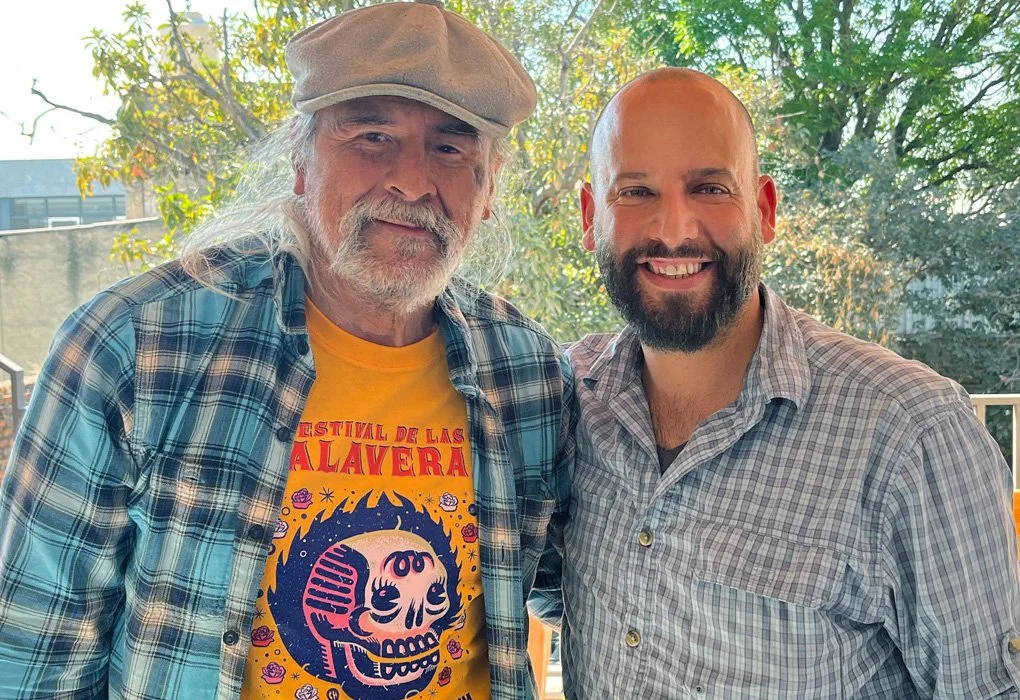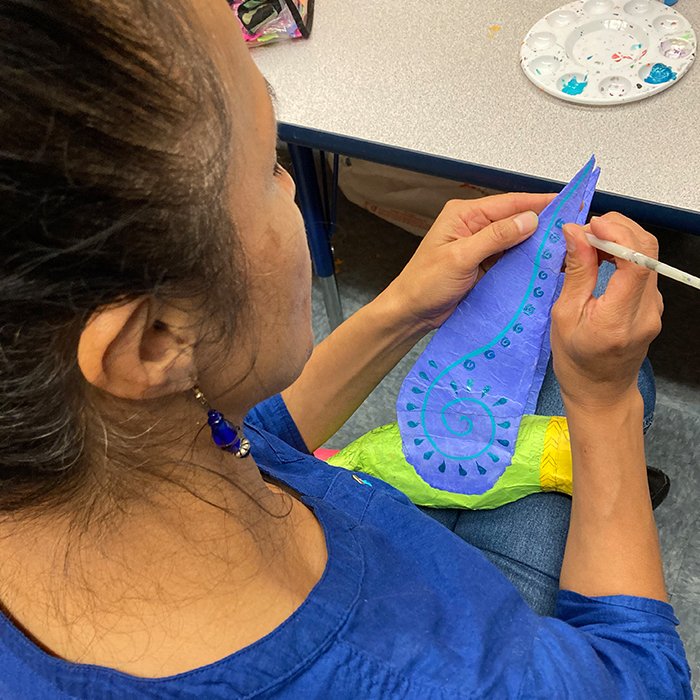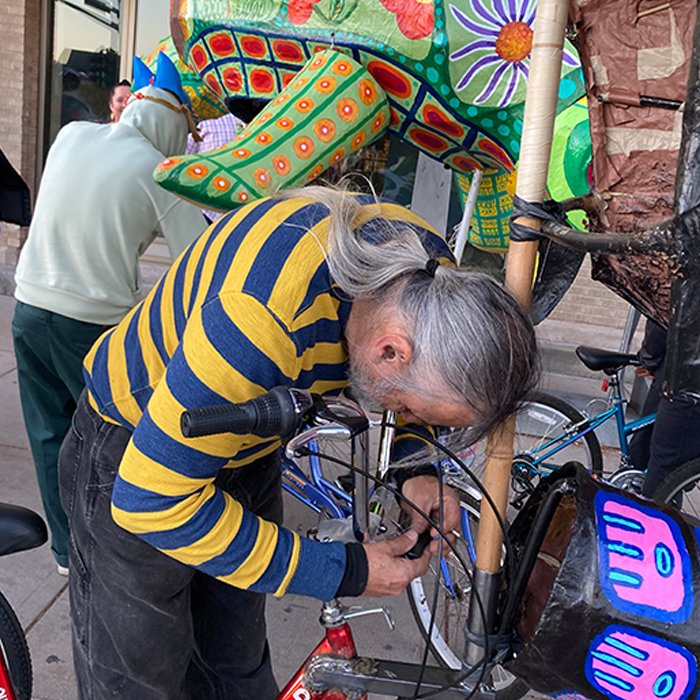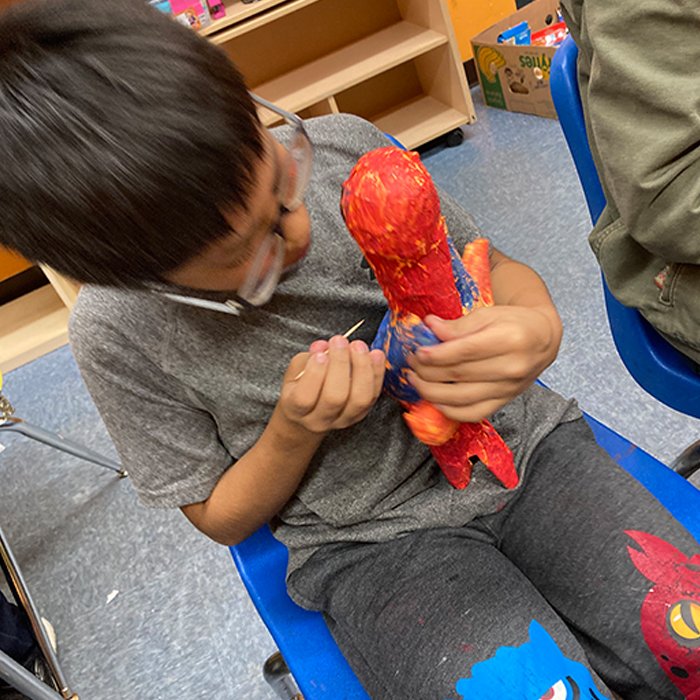The transformational qualities of Alebrije art-making.
March 6, 2023 | Arts & Cultural Affairs
L to R: Jose Cruz, Jose Luis, Josefa Gaona-Pacheco and Norma Gaona at Metamorfosis Alebrije making workshop.
With support from the Creative Response Fund, Gustavo Boada and Aaron Johnson-Ortiz have created delightful and engaging papier-mâché workshops, exhibits and experiences sharing new traditions in the craft of Alebrije art-making through their art project Metamorfosis.
In June of 2022 the City of Minneapolis’ Arts & Cultural Affairs announced funding through the Creative Response Fund for 12 artist-led teams for projects providing creative healing and support to Minneapolis communities that continue to be directly impacted and affected by the stress and trauma of 2020.
For Creative Response Fund recipients, Gustavo Boada and Aaron Johnson-Ortiz, their paths continue to intersect as artists, collaborators, teachers, community cultural influencers and co-founders of their art project Metamorfosis. While Gustavo, a theater-based multidisciplinary artist has transitioned from theater arts to community based artistic projects that prioritize the community’s vision, Aaron has two objectives, personal work with a focus on his Mexican identity, and dreaming big about his collaborations with Gustavo. Both find the process of crafting Alebrijes integral to connecting people to their own creativity, imagination, and artistic traditions.
Interviewed and written by Liz Pangerl. This article has been edited for length and clarity.
Metamorfosis as imagined by Gustavo Boada and Aaron Johnson-Ortiz
Gustavo Boada & Aaron Johnson-Ortiz in Guadalajara, Mexico.
Both Gustavo and Aaron are Latinx artists who work in different mediums yet consistently cross-pollinate their skills and innovative vision and artistic techniques. Aaron Johnson-Ortiz has been working in Latino cultural arts since his youth in the 1990s, and specifically in Minneapolis since 2015. He has worked as a Mexican/Latino cultural organizer, public artist, and muralist with his art focused on workers’ struggles, immigrant rights, Latino/a/x/e culture, and Mexican identities. His Workers United in Struggle mural was named as 2018’s Best Mural by City Pages.
Gustavo Boada is a Heart of the Beast legacy artist and Peruvian maestro (master) in the art of puppetry and widely recognized for his brilliant work over the past 40 years throughout the artistic and theater communities in Minnesota. He recently returned from an artist residency in Guadalajara, Mexico where he immersed himself in a process of consolidation to increase his artistic skills and output, as he described it, “to interpret with intention the voices of the Latino community in Minnesota.”
“Working on the ideation and creation of Alebrijes is a new experience for me over the past two years.” — Gustavo
Gustavo Boada, Alebrije, 2022, papier-mâché, acrylics.
What are Alebrijes?
Alebrijes began to appear as a form of art in Mexico in the 1940s. The final three-dimensional artworks are crafted of papier-mâché, or in the Oaxacan tradition – carving into copal softwood to create brightly painted fantastical mythical creatures. Many have antlers, horns, wings, and fins. Alebrijes symbolize rebirth, healing, spiritual guidance for the dead, and the vibrancy and creativity of Latino culture. They inspire awe, and are visually arresting with their painted repetitive dots and geometric shapes which add depth and texture. The crafting of Alebrijes promotes kinship in communities moving through pain and trauma by gathering to create art in a joyful atmosphere.
Famed Mexican artist Pedro Linares López (1906-1992) is honored as the father of Alebrijes and coined the word (and its plural version) and concept. In 1936, at age 30, he fell extremely ill of peritonitis and suffered feverish hallucinations of his own death and rebirth at the hands of zoomorphic creatures (a donkey with butterfly wings, a rooster with bull horns, and a lion with an eagle head), who he believed saved his life. He later imagined these creatures by molding paper and painting them as they appeared in his dreams.
The combination of selected animals for an Alebrije can also contain qualities of the four elements, air, water, earth, and fire.
Aaron explains Metamorfosis as “aiming to uplift Latino culture through community-engaged arts co-creation. As a caterpillar transforms into a monarch butterfly, so too can community bring wonder and beauty into the world by co-creating Alebrijes.” Art-making is a powerful form for artists to express their own healing, rebirth and transformation, along with impacting viewers in similar and visceral ways.
Alebrije art making workshops and launching the first Alebrije bike parade
A series of Alebrije art-making workshops were hosted by Metamorfosis over the summer of 2022 at various locations including Comunidades Organizando el Poder y la Acción Latina (COPAL), Midtown Global Market, Pillsbury United Communities-Waite House and Squirrel Haus Arts. Waite House historically feels like home to Gustavo who has presented numerous (free) puppet shows at the organization located in the Phillips neighborhood.
It was at Waite House that giant Alebrijes were conceptualized, fabricated, painted, and transformed into mythical creatures who were then harnessed to the shoulders of bike riders. A colorful menagerie for the eyes biking from Waite House to Mercado Central to the Midtown Global Market, along the Greenway and back to Waite House on a sunny Saturday last fall, October 29. Drivers honked their car horns and gestured thumbs-up to the bikers, pedestrians quickly snapped photos, children stopped in their tracks staring in amazement at the vivid Alebrijes. The parade was easily seen by hundreds of drivers, pedestrians and merchants.
The Alebrijes created by Gustavo, Aaron and the workshop participants were exhibited at Squirrel House Arts, on November 12th during the Festival de las Calaveras annual arts festival for Día de los Muertos.
Metamorfosis Alebrije artists Norma Gaona and Josefa Gaona-Pacheco showcased workshopped Alebrijes at Squirrel Haus Arts, during the Festival de las Calaveras.
Reconnecting community
The COVID-19 pandemic and subsequent social isolation led to a significant amount of separation between people and their social connections. Aaron recalls, “we felt compelled to connect our community through our arts and cultural traditions. We also wanted to inspire each person’s creativity and to spark a sense of ownership and pride in their individual and shared artistic traditions.”
Many of the Alebrije workshop participants were families and one couple shared with Gustavo and Aaron the transformation they witnessed in their father-in-law’s participation in a few workshops – a man they described as socially shy who didn’t go out much. Concerned with his wellbeing and mental health they nudged him to join them. Gustavo says with a smile, “once he started making his Alebrije, his personality completely changed. He started creating all kinds of different creatures, and he returned to the workshops and shared with us new Alebrijes he had crafted.” Aaron adds, “the entire experience brought out a well of creativity in this man. Maybe he had felt repressed or unable to access this part of himself before, which was so rich.”
“Can you imagine that a workshop could affect someone so dramatically?” — Aaron
Both artists attest to seeing in real time, real transformations in people of all ages, youngsters to abuelitos (grandparents) who had never made an Alebrije before and just embraced the moment – in a safe space where they were free to express themselves creatively without feeling vulnerable.
Self-discovery is success and artistic expression is healing
Community members participating in the workshops see themselves identified in their work. It’s a process of self-discovery – of their cultural identity along with a reservoir of untapped skill sets, creativity, and innovation. Aaron shared, “a lot of the people who participated in the workshops decided to form their own group so they can fabricate giant Alebrijes. This was great news for me and Gustavo to hear, because it wasn’t an outcome we were expecting.” Gustavo asserted that, “creative healing was evident when we saw diverse community members together in a welcoming and friendly environment. A space full of acceptance, a place where each person was valued, and an atmosphere where positive feedback celebrated each person’s individual creations.”
The energy of the workshops were such that participants may have started out forming a wolf in papier-mâché, and then to the surprise of the maker and others it morphed into a dragon with antlers. The forgiveness of the Alebrije artistic process is liberating. The results can be abstract, inviting viewers to engage with the artists and ask questions about their artworks.
“A lot of the people who participated in the workshops decided to form their own group so they can fabricate giant Alebrijes.” — Aaron
Aaron Johnson-Ortiz, Drawings, 2022, ink on drawing paper. Day of the Dead theme.
Following your bliss
Aaron has fond memories of making puppets as a youngster and drawing, drawing, drawing. He says the movement of a hand drawing on paper or cardboard drew him in, and he loved the markings that in his eyes seemed like windows into a person’s soul, into how they felt, perhaps even into their subconscious. He grew up in Minnesota, and also lived in Guatemala; Chiapas, MX and Germany during his childhood. It wasn’t until grad school and after earning a Master’s in Fine Arts that he became disillusioned with art, in particular as a measurement of success. Surrounded by people who spoke about their work hanging in museums, or a residency in France, or how much more credible one artist was over another became more unappealing to him over time. “I had such a chaotic childhood I learned how to be very adaptable, and as a young graduate I didn’t care if my paintings hung in a coffee shop, or a living room or bathroom, or a museum. What mattered to me was the content and if it made someone feel something rather than the prestige associated with it. And honestly, I think art history supports my values because there have been so many artists, who while living were not recognized at all, or to the extent they should have been.”
After a few years of community organizing work and all the existential challenges associated with the process, Aaron decided to continue community work through the arts. His work now focuses on the soul of the community. Clearly there are corporal needs such as food, shelter, work, security, and yet “each individual has a heart,” he asserts.
“Identity, cultural traditions, family values, beauty, expression – these are holistic values that recognize the humanity of persons as individuals and not just numbers.” — Aaron
Aaron continues, “I want to create a narrative around the value of our community and I’m grateful for Gustavo because he reached out to me about this Creative Response Fund grant, and the timing was perfect so we could continue to collaborate.
Gustavo declared himself an artist at age eight. His grandmother replied, “Oh no! You are going to be poor – and die in the street!”
Left photo: Gustavo, age eight (upper right) with his siblings. Right photo: Gustavo as an adult at one of his early puppet shows.
His quirky grandmother’s dark Latin humor scared little Gustavo into just playing with toys and disassembling them. Gustavo goes on, “I became a lawyer for the General Attorneys Office in Peru, which is like a public defender here in the United States. I had an office, in a building, and I guess I should have been happy, yet something was missing. In my forties I started taking sculpture and mask making classes and then I would visit the theater. It was the theater that became the venue for me to paint, sculpt, perform, tell stories, and create a connection with the audience, the most important aspect of my work today.”
Gustavo Boada reciting a poem on Mother’s Day, 1970 in San Bartolo, Peru and an exuberant Gustavo today.
Gustavo doesn’t dismiss his law career nor anything else he worked at early in life, rather he feels it all informed his art, “many of the best artists are people who came to it later in life. Sometimes when people only do art, it can tend to be very flat. It’s not really focused on community. And communities of color have few opportunities to access the theater, the arts and art that relates to ancestry, roots and culture.” One could reason that Gustavo shed a suit for a smock and transformed himself into a public defender of the arts.
Gustavo continues, “culture is the step forward to connect with one’s own identity – it builds and empowers self-esteem which leads to breaking barriers many marginalized people struggle to overcome. It provides individual strength and collectivity. People see the value of their work, their ancestry, roots and the historical cultures that came before them.” The Alebrije workshops provide spaces for participants to ask questions of Gustavo and Aaron related to history, and how the arts are the unconscious fiber that connects us all with our ancestry.
“At my puppet shows at Waite House, many times I cried along with my audience. I felt like I was helping to fix things.” — Gustavo
Gustavo and Aaron are dreaming big, biG, BIG!
Gustavo and Aaron have grand aspirations, and a bigger than life vision for creating Alebrijes in Minnesota. One, being the continuation of the bike parades and expanding to other locations around the state; two, working with the Alebrije art group which hatched out of the Metamorfosis workshops and growing the Phillips, Powderhorn and Lake street neighborhood folks to join the movement; three, to present a statewide exhibit featuring hundreds of giant Alebrije creations possibly in 2026, similar to the outdoor exhibit, Alebrijes: Creatures of a Dream World, held at Cantigny Park in Wheaton, Illinois summer of 2022.
The Creative Response Fund grant from the Arts & Cultural Affairs Department, while making a positive impact on many participants and people living in and around cultural districts, the future of ideas such as Aaron and Gustavo’s depend on ongoing financial support. The City of Minneapolis’ Arts & Cultural Affairs mission is more relevant and important than ever: Powering Minneapolis’ economic and social growth through support for community artists, cultural expression and creativity in our neighborhoods.
Gustavo Boada, Facebook
Gustavo Boada, The Little Coyote Puppet Theater, Facebook
Stay in the loop by checking in on Arts & Cultural Affairs calendar of events.
Publisher's Note: The name, "The Office of Arts, Culture & the Creative Economy" has been updated on August 13, 2023 where it appeared within the content of this article to "Arts & Cultural Affairs" to reflect its new name as a department of the City of Minneapolis.



























